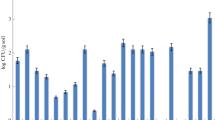Abstract
Development and activity of the association of the sulphur cycle bacteria, represented byThiobacillus thioparus andDesulfovibrio sp., were followed in chernozem soil continuously supplemented with sodium thiosulphate. The technique of heterocontinuous cultivation made it possible (i) to determine changes in the individual components of microflora involved in successive metabolic steps, their time and space sequence, (ii) to follow changes in the transformations of substrate and formation of metabolic products, and (iii) to reach a steady state in the system. A possible use of this approach for the evaluation of the effect of ecological factors, for modelling microbiological processes of the sulphur cycle, for the investigation of trophic relationships among microorganisms in natural and artificial association and for the evaluation of the geochemical activity of sulphur bacteria is discussed.
Similar content being viewed by others
References
Andreyuk E.I., Kozlova I.A.:Litotrophic Bacteria and Microbiological Corrosion. (In Russian) Naukova Dumka, Kiev 1977.
Busev A.I., Simonova L.N.:Analytical Chemistry of Sulphur. (In Russian) Nauka, Moscow 1975.
Karavayko G.I., Kuznetsov S.I., Golomzik A.I.:The Bole of Microorganisms in Leaching of Metals from Ores. (In Russian) Nauka, Moscow 1972.
Lur’ye Yu. Yu.:Unified Methods of Water Analysis. (In Russian) Khimiya, Moscow 1971.
Macura J.: Continuous flow method in soil microbiology. I. Apparatus.Folia Microbiol. 6, 328 (1961).
Macura J., Kuno F.: Continuous flow method in soil microbiology. IV. Decomposition of glycine.Folia Microbiol. 10, 115 (1965a).
Macura J., Kunc F.: Continuous flow method in soil microbiology. V. Nitrification.Folia Microbiol. 10, 125 (1965b).
Romanenko V.I., Kuznetsov S.I.:Ecology of Microorganisms of Fresh Water Reservoirs. (In Russian) Nauka, Moscow 1974.
Starkey R.L.: Relation of microorganisms to transformation of sulphur in soils.Soil Sci. 70, 55 (1950).
Starkey R.L.: Oxidation and reduction of sulphur compounds in soils.Soil Sci. 101, 297 (1966).
Tsugio S., Tadaaki M., Taijiro O.: Oxidation of inorganic sulfur compounds by Thiobacilli.J. Ferment. Technol. 54, 361 (1976).
Zyrin N.G., Orlov D.S.:Physico-chemical Methods of Soil Investigations. (In Russian) Publ. House of Moscow State University, Moscow 1980.
Author information
Authors and Affiliations
Rights and permissions
About this article
Cite this article
Andreyuk, E.I., Kunc, F., Shevchenko, S.I. et al. Microbial transformations of inorganic sulphur compounds in soil under conditions of heterocontinuous cultivation. Folia Microbiol 27, 428–432 (1982). https://doi.org/10.1007/BF02876455
Received:
Issue Date:
DOI: https://doi.org/10.1007/BF02876455



